Construction and Analysis of Space–Time Paths for Moving Polygon Objects Based on Time Geography: A Case Study of Crime Events in the City of London
Abstract
1. Introduction
2. Background
2.1. Time Geography
2.2. Crime Data Characteristics
2.3. Time Geography in Crime Research
3. Measurement of Crime Events’ Mobility
3.1. Construction of Space-Time Path Using Crime Point Sets
3.1.1. Extraction of Crime Control Points
3.1.2. Construction of Crime Space–Time Paths
3.2. Geometric Analysis of Crime Space–Time Paths
3.2.1. The Vectors of Crime Space-Time Paths
3.2.2. Statistical Analyses of Monthly Vectors
3.2.3. Geometric Conclusion of Crime Space-Time Paths
4. Experiments
4.1. Data Source and Its Preprocessing
4.2. Construction of Crime Space-Time Paths
4.3. Statistical Analysis of Crime Displacement Characteristics
5. Conclusions and Discussion
Author Contributions
Funding
Data Availability Statement
Acknowledgments
Conflicts of Interest
References
- Miller, H.J. A measurement theory for time geography. Geogr. Anal. 2005, 37, 17–45. [Google Scholar] [CrossRef]
- Yin, Z.; Huang, W.; Ying, S.; Tang, P.; Kang, Z.; Huang, K. Measuring of the COVID-19 Based on Time-Geography. Int. J. Environ. Res. Public Health 2021, 18, 10313. [Google Scholar] [CrossRef]
- Hägerstraand, T. What about People in Regional Science? Pap. Reg. Sci. 1970, 24, 7–24. [Google Scholar] [CrossRef]
- Dijst, M.; Vidakovic, V. Travel time ratio: The key factor of spatial reach. Transportation 2000, 27, 179–199. [Google Scholar] [CrossRef]
- Forer, P. Geometric approaches to the nexus of time, space, and microprocess: Implementing a practical model for mundane socio-spatial systems. In Spatial and Temporal Reasoning in Geographic Information Systems; Oxford University Press: Oxford, UK, 1998; pp. 171–190. [Google Scholar]
- Thrift, N. An introduction to time-geography. In Geo Abstracts; University of East Anglia: Norwich, UK, 1977; pp. 1–17. [Google Scholar]
- Lu, P.; Xu, M.; Sun, A.; Wang, Z.; Zheng, Z. Typhoon Tracks Prediction with ConvLSTM Fused Reanalysis Data. Electronics 2022, 11, 3279. [Google Scholar] [CrossRef]
- Kwan, M.-P. Interactive geovisualization of activity-travel patterns using three-dimensional geographical information systems: A methodological exploration with a large data set. Transp. Res. Part C Emerg. Technol. 2000, 8, 185–203. [Google Scholar] [CrossRef]
- Vrotsou, K.; Andersson, G.; Ellegård, K.; Stefansson, C.-G.; Topor, A.; Denhov, A.; Bülow, P. A time-geographic approach for visualizing the paths of intervention for persons with severe mental illness. Geogr. Ann. Ser. B Hum. Geogr. 2017, 99, 341–359. [Google Scholar] [CrossRef]
- Widener, M.J.; Minaker, L.; Farber, S.; Allen, J.; Vitali, B.; Coleman, P.C.; Cook, B. How do changes in the daily food and transportation environments affect grocery store accessibility? Appl. Geogr. 2017, 83, 46–62. [Google Scholar] [CrossRef]
- Xu, Y.; Li, J.; Xue, J.; Park, S.; Li, Q. Tourism geography through the lens of time use: A computational framework using fine-grained mobile phone data. Ann. Am. Assoc. Geogr. 2021, 111, 1420–1444. [Google Scholar] [CrossRef]
- Chen, B.Y.; Wang, Y.; Wang, D.; Li, Q.; Lam, W.H.; Shaw, S.-L. Understanding the impacts of human mobility on accessibility using massive mobile phone tracking data. Ann. Am. Assoc. Geogr. 2018, 108, 1115–1133. [Google Scholar] [CrossRef]
- Dodge, S.; Su, R.; Johnson, J.; Simcharoen, A.; Goulias, K.; Smith, J.L.; Ahearn, S.C. ORTEGA: An object-oriented time-geographic analytical approach to trace space-time contact patterns in movement data. Comput. Environ. Urban Syst. 2021, 88, 101630. [Google Scholar] [CrossRef]
- Tian, H.; Ma, X.; Wang, H.; Song, G.; Xie, K. A novel approach to estimate human space-time path based on mobile phone call records. In Proceedings of the 2010 18th International Conference on Geoinformatics, Beijing, China, 18–20 June 2010; pp. 1–6. [Google Scholar] [CrossRef]
- Yin, Z.-C.; Wu, Y.; Winter, S.; Hu, L.-F.; Huang, J.-J. Random encounters in probabilistic time geography. Int. J. Geogr. Inf. Sci. 2018, 32, 1026–1042. [Google Scholar] [CrossRef]
- Shi, W.; Chen, P.; Shen, X.; Liu, J. An adaptive approach for modelling the movement uncertainty in trajectory data based on the concept of error ellipses. Int. J. Geogr. Inf. Sci. 2021, 35, 1131–1154. [Google Scholar] [CrossRef]
- Andersson, G.; Ellegård, K.; Bülow, P.; Denhov, A.; Vrotsou, K.; Stefansson, C.-G.; Topor, A. A longitudinal study of men and women diagnosed with psychosis: Trajectories revealing interventions in a time-geographic framework. GeoJournal 2019, 87, 2423–2440. [Google Scholar] [CrossRef]
- Griffiths, G.; Johnson, S.D.; Chetty, K. UK-based terrorists’ antecedent behavior: A spatial and temporal analysis. Appl. Geogr. 2017, 86, 274–282. [Google Scholar] [CrossRef]
- Downs, J.A. Mapping sex offender activity spaces relative to crime using time-geographic methods. Ann. GIS 2016, 22, 141–150. [Google Scholar] [CrossRef]
- Virtanen, S.; Girolami, M. Spatio-temporal mixed membership models for criminal activity. J. R. Stat. Soc. Ser. A Stat. Soc. 2021, 184, 1220–1244. [Google Scholar] [CrossRef]
- Yu, D.; Fang, C. How neighborhood characteristics influence neighborhood crimes: A Bayesian hierarchical spatial analysis. Int. J. Environ. Res. Public Health 2022, 19, 11416. [Google Scholar] [CrossRef]
- Wüllenweber, S.; Burrell, A. Offence characteristics: A comparison of lone, duo, and 3+ perpetrator robbery offences. Psychol. Crime Law 2021, 27, 122–139. [Google Scholar] [CrossRef]
- Andresen, M.A. Theorizing globally, but analyzing locally: The importance of geographically weighted regression in crime analysis. Crime Sci. 2022, 11, 10. [Google Scholar] [CrossRef]
- Ramos, R.G.; Melo, S.N. Income inequality and the geography of residential burglaries: A spatial model applied to Campinas, Brazil. Appl. Geogr. 2022, 147, 102787. [Google Scholar] [CrossRef]
- Zahnow, R.; Zhang, M.; Corcoran, J. The girl on the bus: Familiar faces in daily travel and their implications for crime protection. Ann. Am. Assoc. Geogr. 2021, 111, 1367–1384. [Google Scholar] [CrossRef]
- Cheng, W.; Rao, Y.; Tang, Y.; Yang, J.; Chen, Y.; Peng, L.; Hao, J. Identifying the spatio-temporal characteristics of crime in Liangshan Prefecture, China. Int. J. Environ. Res. Public Health 2022, 19, 10862. [Google Scholar] [CrossRef] [PubMed]
- Zhu, H.; Wang, F. An agent-based model for simulating urban crime with improved daily routines. Comput. Environ. Urban Syst. 2021, 89, 101680. [Google Scholar] [CrossRef]
- Mazeika, D. The effect of unreported gun-related violent crime on crime hot spots. Secur. J. 2022, 36, 101–117. [Google Scholar] [CrossRef]
- DeLang, M.; Taheri, S.A.; Hutchison, R.; Hawke, N. Tackling UCR’s missing data problem: A multiple imputation approach. J. Crim. Justice 2022, 79, 101882. [Google Scholar] [CrossRef]
- Grubesic, T.H.; Mack, E.A. Spatio-temporal interaction of urban crime. J. Quant. Criminol. 2008, 24, 285–306. [Google Scholar] [CrossRef]
- van Sleeuwen, S.E.; Steenbeek, W.; Ruiter, S. When do offenders commit crime? An analysis of temporal consistency in individual offending patterns. J. Quant. Criminol. 2021, 37, 863–889. [Google Scholar] [CrossRef]
- Kuijpers, B.; Grimson, R.; Othman, W. An analytic solution to the alibi query in the space–time prisms model for moving object data. Int. J. Geogr. Inf. Sci. 2011, 25, 293–322. [Google Scholar] [CrossRef]
- Egenhofer, M. Approximation of geopatial lifelines. In Proceedings of the SpadaGIS, Workshop on Spatial Data and Geographic Information Systsems; University of Genova: Genova, Italy, 2003; pp. 1–5. [Google Scholar]
- Morgan, J.D. A Visual Time-Geographic Approach to Crime Mapping; The Florida State University: Tallahassee, FL, USA, 2010. [Google Scholar]
- Downs, J.A. Using potential path trees to map sex offender access to schools. Appl. Spat. Anal. Policy 2014, 7, 381–394. [Google Scholar] [CrossRef]
- Cummings, A.R.; Markandey, N.; Das, H.; Arredondo, C.; Wehenkel, A.; Tiemann, B.L.; Lee, G. The spill over of crime from urban centers: An account of the changing spatial distribution of violent crime in Guyana. ISPRS Int. J. Geo-Inf. 2019, 8, 481. [Google Scholar] [CrossRef]
- Zorigt, T.; Ito, S.; Isoda, N.; Furuta, Y.; Shawa, M.; Norov, N.; Lkham, B.; Enkhtuya, J.; Higashi, H. Risk factors and spatio-temporal patterns of livestock anthrax in Khuvsgul Province, Mongolia. PLoS ONE 2021, 16, e0260299. [Google Scholar] [CrossRef] [PubMed]
- Mitchel, A. The ESRI Guide to GIS Analysis, Volume 2: Spartial Measurements and Statistics; ESRI Press: Redlands, CA, USA, 2005. [Google Scholar]
- Zhang, J.; Goodchild, M.F. Uncertainty in Geographical Information; CRC Press: London, UK, 2002. [Google Scholar] [CrossRef]
- Brunsdon, C.; Corcoran, J.; Higgs, G.; Ware, A. The influence of weather on local geographical patterns of police calls for service. Environ. Plan. B Plan. Des. 2009, 36, 906–926. [Google Scholar] [CrossRef]
- Nakaya, T.; Yano, K. Visualising crime clusters in a space-time cube: An exploratory data-analysis approach using space-time kernel density estimation and scan statistics. Trans. GIS 2010, 14, 223–239. [Google Scholar] [CrossRef]
- Roach, J.; Pease, K. Police overestimation of criminal career homogeneity. J. Investig. Psychol. Offender Profiling 2014, 11, 164–178. [Google Scholar] [CrossRef]
- Zhu, X.; Guo, D. Mapping large spatial flow data with hierarchical clustering. Trans. GIS 2014, 18, 421–435. [Google Scholar] [CrossRef]
- Zhou, X. Understanding spatiotemporal patterns of biking behavior by analyzing massive bike sharing data in Chicago. PLoS ONE 2015, 10, e0137922. [Google Scholar] [CrossRef] [PubMed]
- Eck, J.; Chainey, S.; Cameron, J.; Wilson, R. Mapping Crime: Understanding Hotspots; National Institute of Justice: Washington, DC, USA, 2005. [Google Scholar]
- ToppiReddy, H.K.R.; Saini, B.; Mahajan, G. Crime prediction & monitoring framework based on spatial analysis. Procedia Comput. Sci. 2018, 132, 696–705. [Google Scholar] [CrossRef]
- Reppetto, T.A. Crime prevention and the displacement phenomenon. Crime Delinq. 1976, 22, 166–177. [Google Scholar] [CrossRef]
- Weisburd, D.; Wyckoff, L.A.; Ready, J.; Eck, J.E.; Hinkle, J.C.; Gajewski, F. Does crime just move around the corner? A controlled study of spatial displacement and diffusion of crime control benefits. Criminology 2006, 44, 549–592. [Google Scholar] [CrossRef]
- Lewis, L.; Alford, J. The influence of season on assault. Prof. Geogr. 1975, 27, 214–217. [Google Scholar] [CrossRef]
- Sun, Y.; Huang, Y.; Yuan, K.; Chan, T.O.; Wang, Y. Spatial patterns of COVID-19 incidence in relation to crime rate across London. ISPRS Int. J. Geo-Inf. 2021, 10, 53. [Google Scholar] [CrossRef]
- Andresen, M.A.; Malleson, N. Crime seasonality and its variations across space. Appl. Geogr. 2013, 43, 25–35. [Google Scholar] [CrossRef]
- Ceccato, V.; Uittenbogaard, A.C. Space–time dynamics of crime in transport nodes. Ann. Assoc. Am. Geogr. 2014, 104, 131–150. [Google Scholar] [CrossRef]
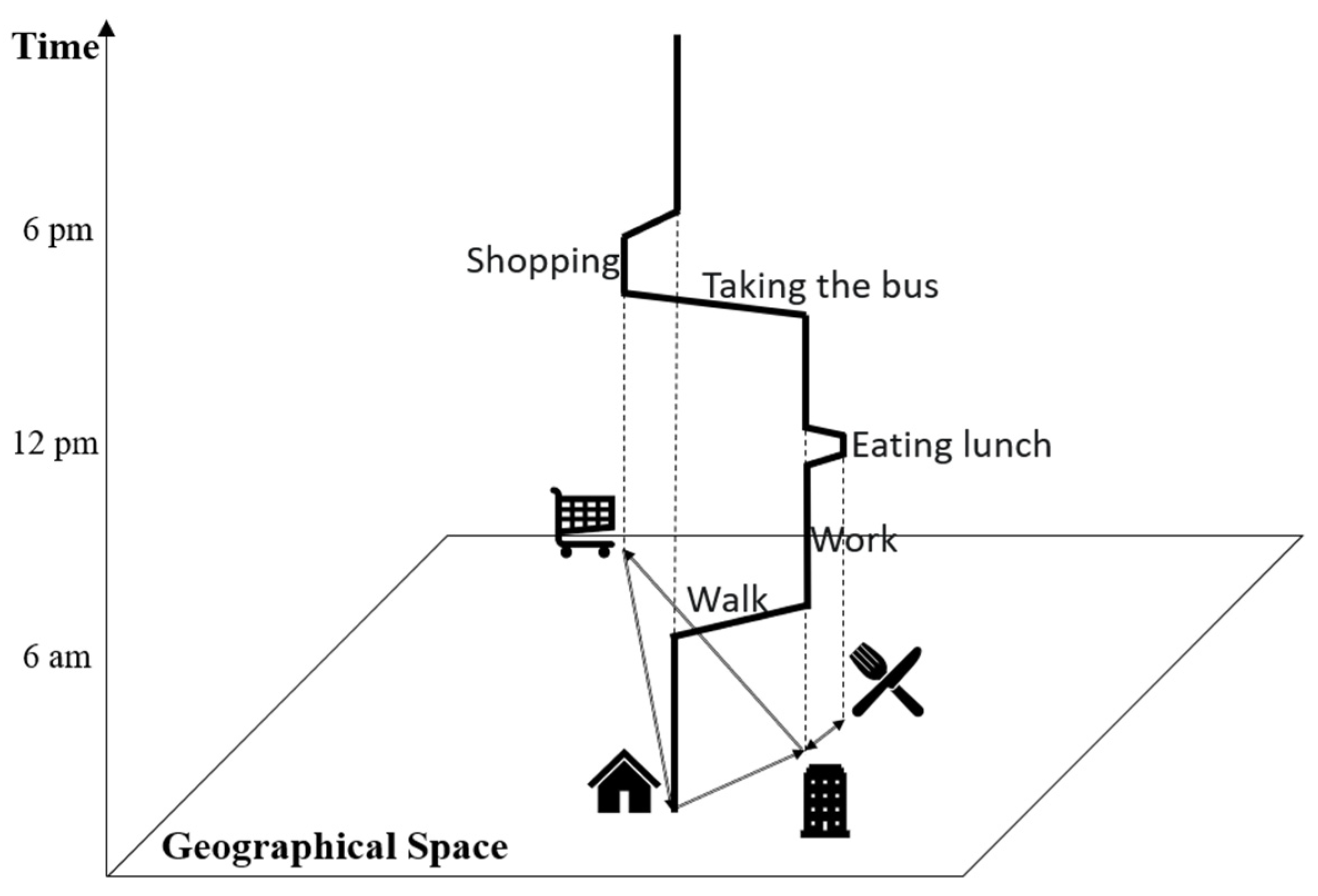
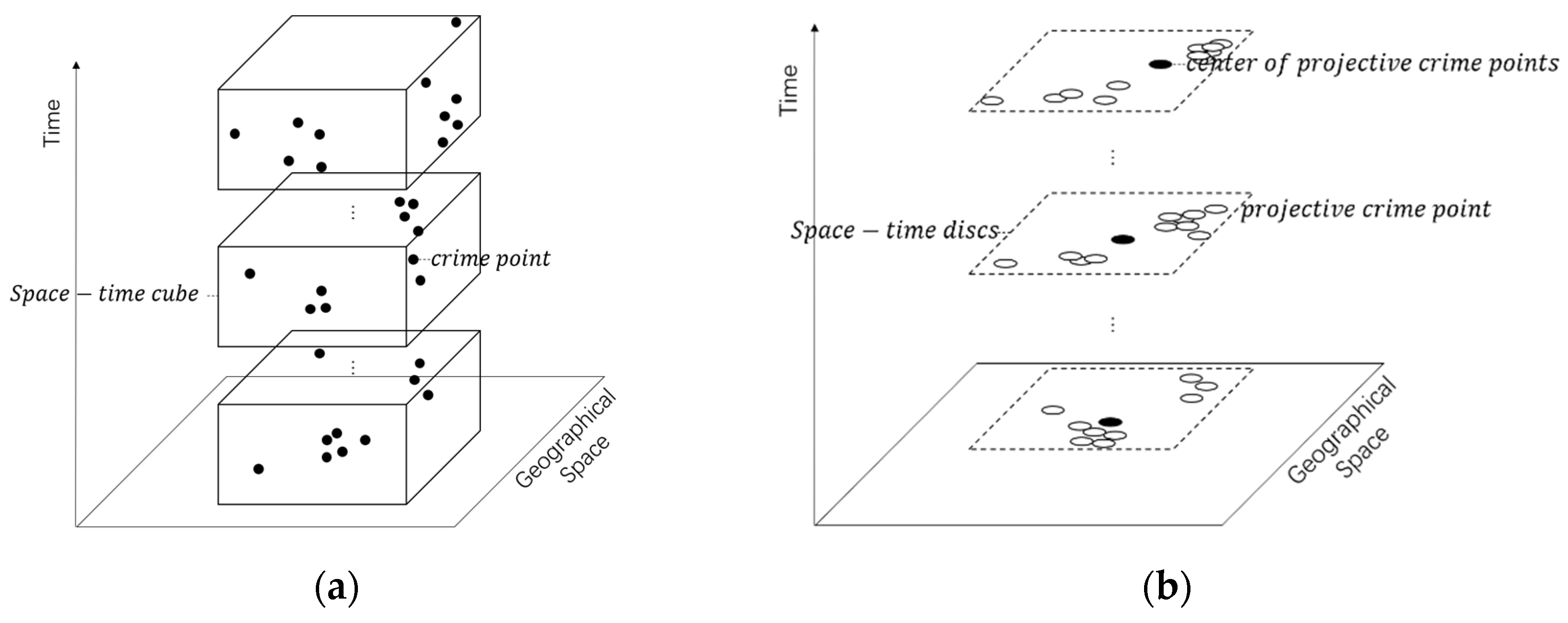

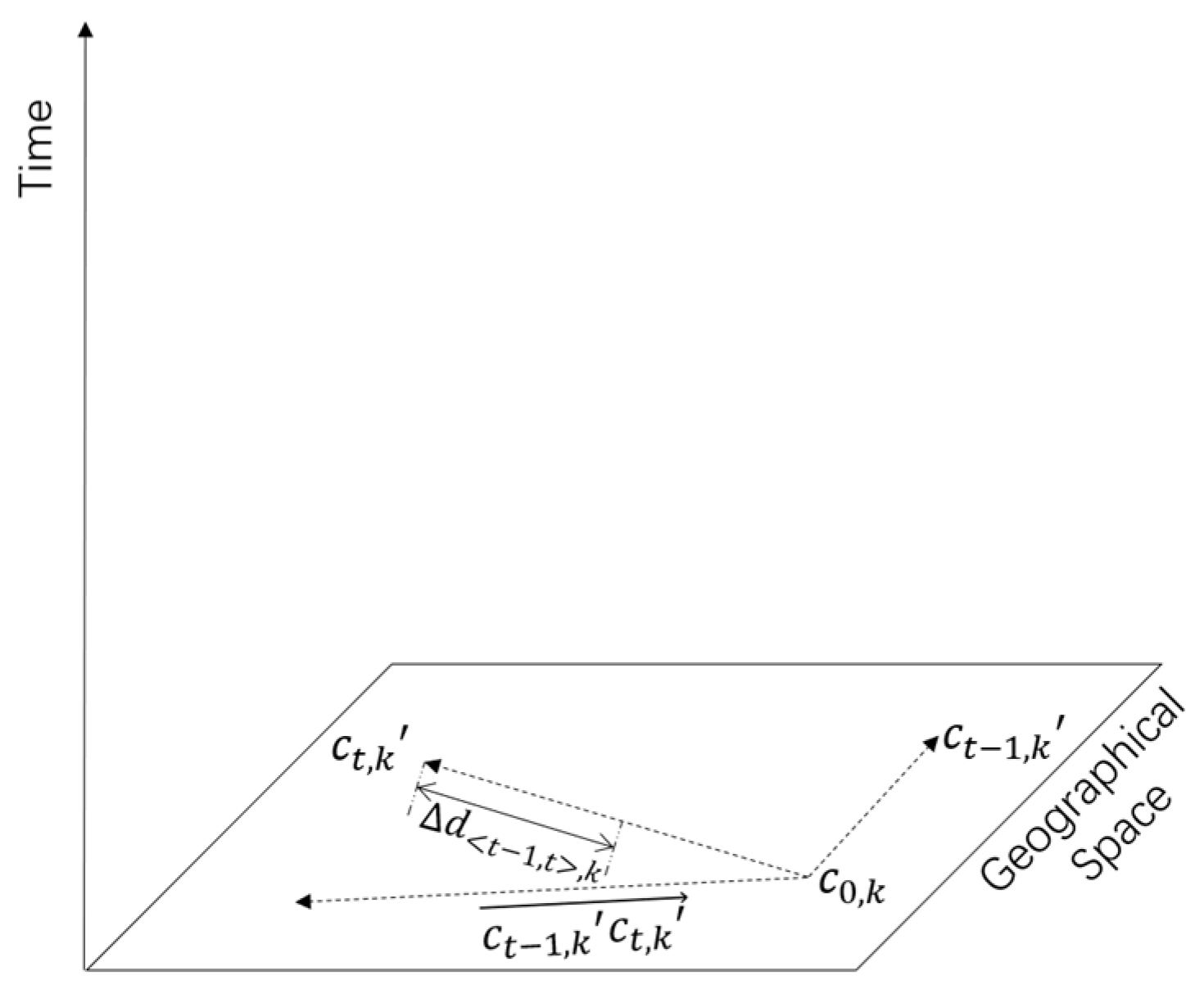
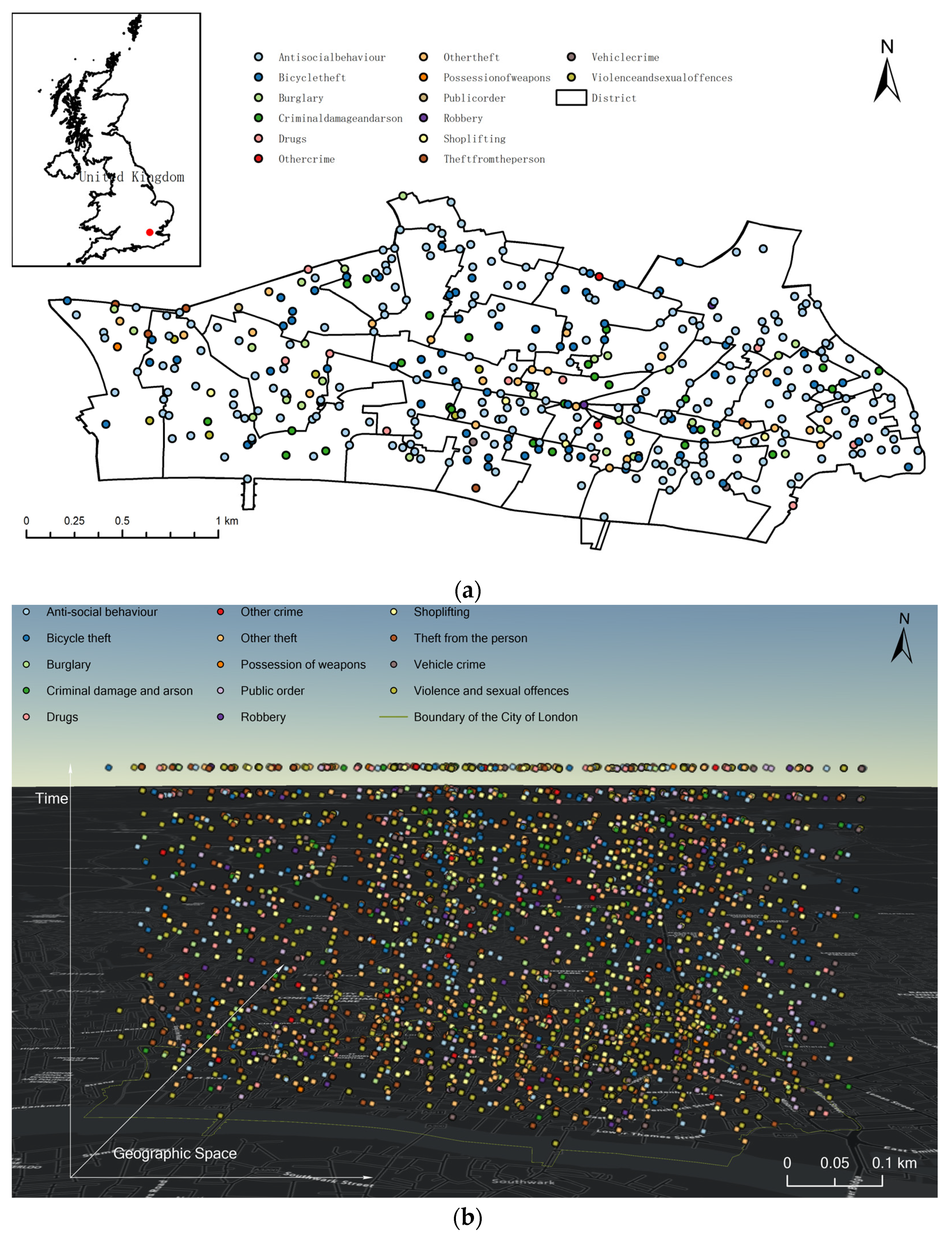
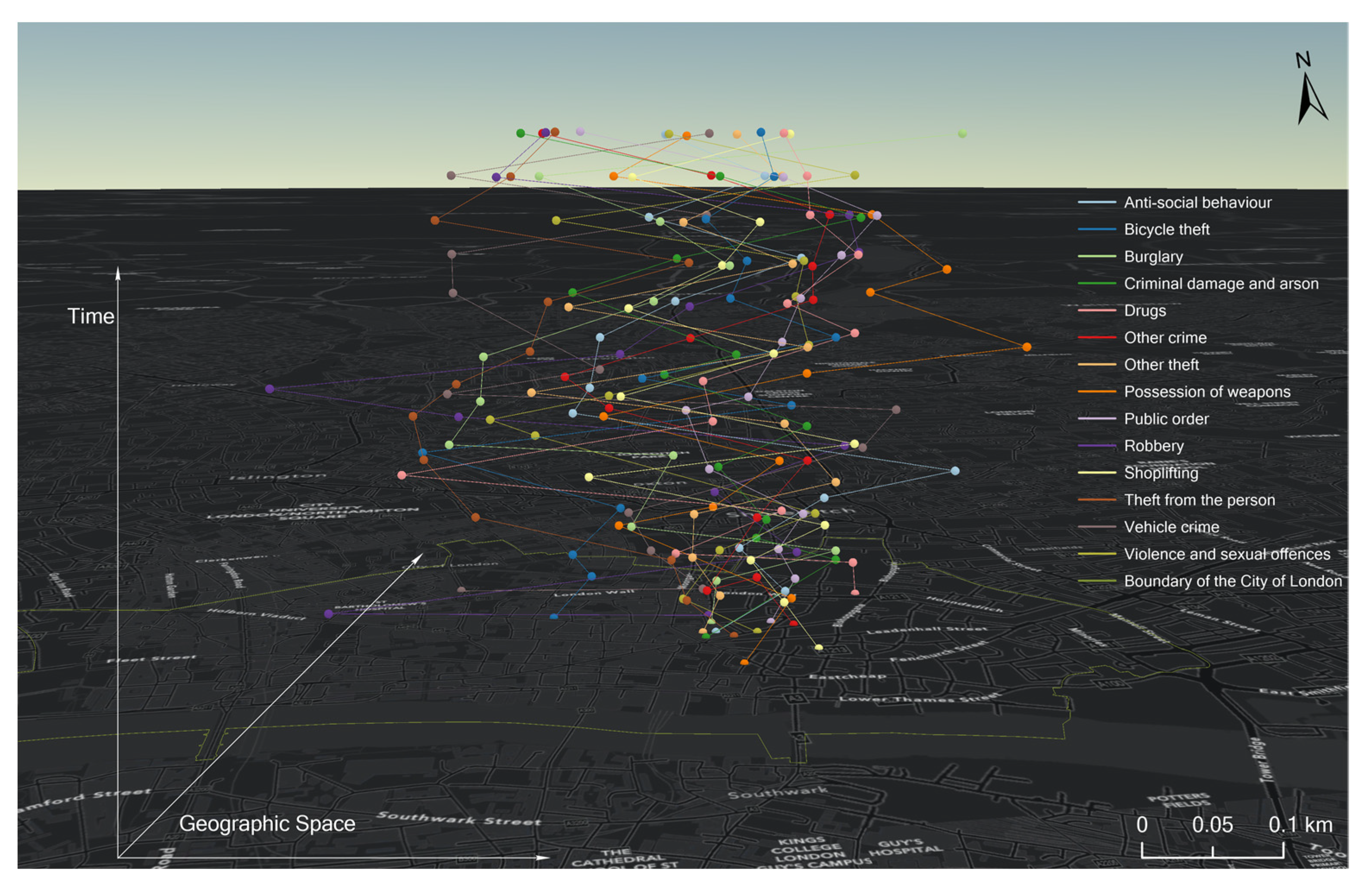


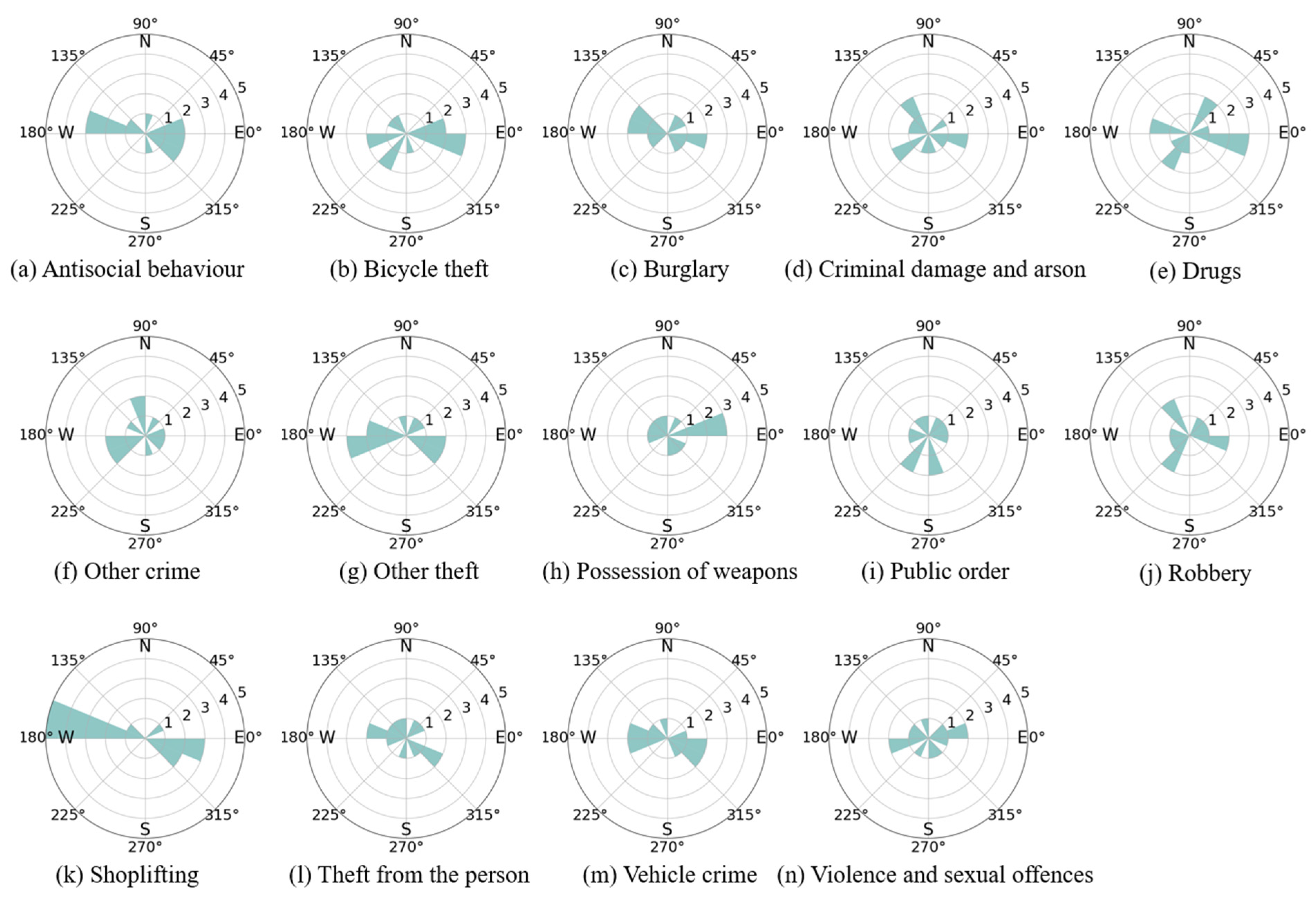

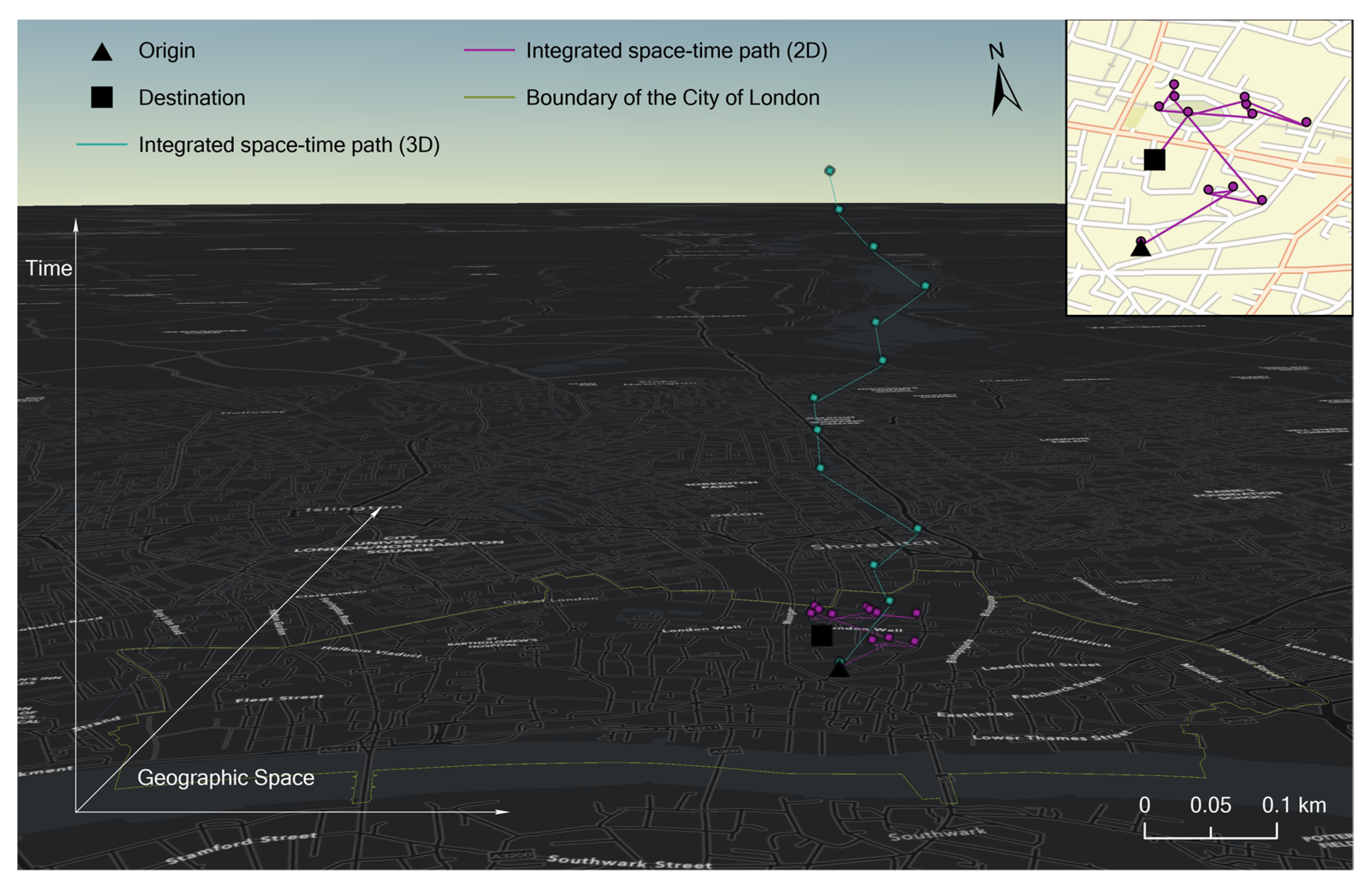
The norms distribute narrowly, and stability is strong. | The norms distribute widely, and stability is week. | |
The norms and crime displacements are generally small. | Crime hotspots should be actively regulated. | Crime hotspots should be monitored intensively in months when crime displacement is small, but not in other months. |
The norms and crime displacements are generally large. | Police resources should be expanded beyond hotspots. | The scope of police resource allocation should be broad in general, and its location should be adjusted with time. |
Disclaimer/Publisher’s Note: The statements, opinions and data contained in all publications are solely those of the individual author(s) and contributor(s) and not of MDPI and/or the editor(s). MDPI and/or the editor(s) disclaim responsibility for any injury to people or property resulting from any ideas, methods, instructions or products referred to in the content. |
© 2023 by the authors. Licensee MDPI, Basel, Switzerland. This article is an open access article distributed under the terms and conditions of the Creative Commons Attribution (CC BY) license (https://creativecommons.org/licenses/by/4.0/).
Share and Cite
Yin, Z.; Chen, Y.; Ying, S. Construction and Analysis of Space–Time Paths for Moving Polygon Objects Based on Time Geography: A Case Study of Crime Events in the City of London. ISPRS Int. J. Geo-Inf. 2023, 12, 210. https://doi.org/10.3390/ijgi12060210
Yin Z, Chen Y, Ying S. Construction and Analysis of Space–Time Paths for Moving Polygon Objects Based on Time Geography: A Case Study of Crime Events in the City of London. ISPRS International Journal of Geo-Information. 2023; 12(6):210. https://doi.org/10.3390/ijgi12060210
Chicago/Turabian StyleYin, Zhangcai, Yuan Chen, and Shen Ying. 2023. "Construction and Analysis of Space–Time Paths for Moving Polygon Objects Based on Time Geography: A Case Study of Crime Events in the City of London" ISPRS International Journal of Geo-Information 12, no. 6: 210. https://doi.org/10.3390/ijgi12060210
APA StyleYin, Z., Chen, Y., & Ying, S. (2023). Construction and Analysis of Space–Time Paths for Moving Polygon Objects Based on Time Geography: A Case Study of Crime Events in the City of London. ISPRS International Journal of Geo-Information, 12(6), 210. https://doi.org/10.3390/ijgi12060210







